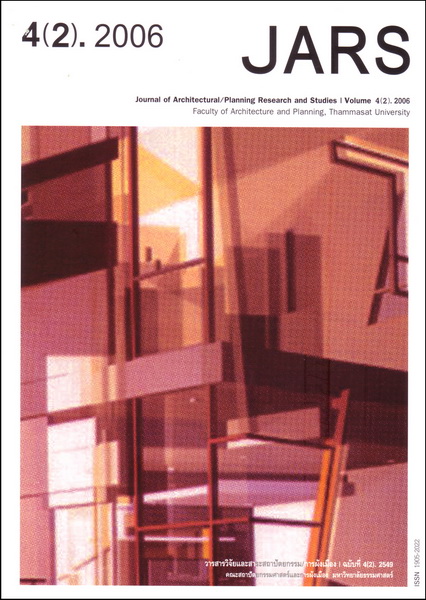Radon: The Hidden Hazard in Buildings
Main Article Content
Abstract
Radon is a ubiquitous radioactive noble gas, which has no taste, smell nor color, and cannot be
detected by any of human’s sensations. It is known to be the first leading cause of lung cancer among nonsmokers.
As a result, radon has been recognized as one of the most hazardous indoor air pollutions exposed
to human beings. There are numerous research about physical properties of radon, and its effect on human
and animals, as well as techniques of radon reduction in building. Besides, many countries have promulgated
a standard for radon concentration in building (such as the United States of America, the United Kingdom,
the Netherlands, and Germany).
One of the most effective ways of radon prevention is to tackle to problem at its root during the initial
building design process. Nowadays, there are many techniques to prevent buildings from radon entering as
such active soil-depressurization, building pressurization, etc. Each technique is different in effectiveness as
well as pros and cons depending on building types and budgets. Therefore, architects play a very important
role in order to reduce radon gas in buildings as much as possible which will affect people’s well being and
quality of life in the future.
Downloads
Article Details

This work is licensed under a Creative Commons Attribution-NonCommercial-NoDerivatives 4.0 International License.
All material is licensed under the terms of the Creative Commons Attribution 4.0 International (CC-BY-NC-ND 4.0) License, unless otherwise stated. As such, authors are free to share, copy, and redistribute the material in any medium or format. The authors must give appropriate credit, provide a link to the license, and indicate if changes were made. The authors may do so in any reasonable manner, but not in any way that suggests the licensor endorses you or your use. The authors may not use the material for commercial purposes. If the authors remix, transform, or build upon the material, they may not distribute the modified material, unless permission is obtained from JARS. Final, accepted versions of the paper may be posted on third party repositories, provided appropriate acknowledgement to the original source is clearly noted.
References
The American Society of Heating Refrigerating and Air-conditioning Engineers. (1993). ASHRAE Fundamentals Handbook: Air contaminants. Atlanta: ASHRAE.
Nagda, N. L. (1994). Radon: Prevalence, measurements, health risks and control. Philadelphia, PA: ASTM Publication, 1–10.
Bodansky, D. (1987). Overview of the indoor radon problem. Indoor radon and its hazards. Seattle: University of Washington Press, 1–16.
ไอโซโทป (Isotope) คือ อะตอมของธาตุเดียวกัน ซึ่งในนิวเคลียสมีจำนวนโปรตอนเท่ากัน แต่มีจำนวนนิวตรอนต่างกัน เช่น ธาตุไฮโดรเจนมี 3 ไอโซโทป ได้แก่ 1 1H 21H 31H ไอโซโทปของธาตุเดียวกันจะมีคุณสมบัติทางเคมีเหมือนกัน แต่คุณสมบัติ ทางฟิสิกส์ต่างกัน
Sextro, R. G. (1994). Radon and the natural environment. In N. L. Nagda, Radon: Prevalence, measurements, health risks and control. Philadelphia: PA, 10.
Duval, J. (1988). Indoor radon predicting using gamma ray spectrometric data. EOS, Transactions of Am Geophysics Union, 70, 496.
วรวิทย์ รัตนวงษ์ และคณะ. (2547). เรดอนมหันตภัยร้ายที่ก่อให้เกิดมะเร็งปอด. วารสารวิทยาศาสตร์ประยุกต์, 3 (2).
United States Environmental Protection Agency (US EPA). (1992). Indoor air – radon (Rn). Retrieved from http://www.epa.gov/radiation/radionuclides/radon.htm.
GT. Analytic KEG. Radon measuring instruments. Retrieved from http://www.gt-analytic.at/engl about_radon.htm.
United States Environmental Protection Agency (US EPA). (1994). Radon preventing in the design and construction of schools and other large buildings. Washington DC, 10.
Wilkening, M. (1990). Radon in the environment. Netherlands: Elsevier Science Publishers, B.V.
United States Environmental Protection Agency (US EPA). (1987). Interim protocols for screening and follow-up radon and radon decay product measurements. Washington DC.
United States Environmental Protection Agency (US EPA). (1986). Interim indoor radon and radon decay product measurement protocols. Washington DC.
European Concerted Action. (1988). Radon in indoor air. Indoor air quality and its impact on man. Luxembourg: Office for Official Publications of the European Communities.
International Commission on Radiological Protection (ICRP). (1991). 1990 Recommendations of the International Commission on Radiological Protection. ICRP Publication 60, Annual of the ICRP, 21(1–3). Oxford: Pergamon Press.
United States Environmental Protection Agency (US EPA). (1992). National emission standards for hazardous air pollutants: Emission standards for radon emissions from phosphogypsum stacks. Federal Register. Final Rule (40CFR61). 57(107): 23305.
ธวัช ชิตตระการ. (2540). เรดอน ภัยเงียบใกล้ตัว. นิวเคลียร์ปริทัศน์, 12(1), 11–18.
United States Environmental Protection Agency (US EPA). (1993). Radon reduction techniques for existing detached houses. Technical guidances for active soil depressurization systems.
กองเศรษฐธรณีวิทยา กรมทรัพยากรธรณี กระทรวงอุตสาหกรรม. (2543). แหล่งแร่ยูเรเนียมในประเทศไทย, 4–7.
Polpong P., M.sc., Aksornintra M., Poshpakom R., M.D., M.sc. Med., & Bovornkitti S., M.D., D.sc. Med. (1995). Indoor radon and lung cancer. Sirirat Hosp Gaz, 47(6), 503–508.


